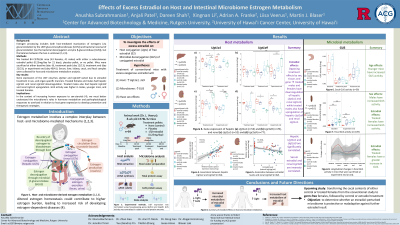Tuesday Poster Session
Category: Colon
P3641 - Effects of Excess Estradiol on Host and Intestinal Microbiome Estrogen Metabolism
Tuesday, October 29, 2024
10:30 AM - 4:00 PM ET
Location: Exhibit Hall E

Has Audio
- AS
Anushka Subrahmanian, BA
Center for Advanced Biotechnology and Medicine, Rutgers University
Piscataway, NJ
Presenting Author(s)
Anushka Subrahmanian, BA1, Anjali Patel, BA1, Dareen Shah, 1, Xingnan Li, PhD2, Adrian Franke, PhD2, Liisa Veerus, PhD1, Martin Blaser, MD1
1Center for Advanced Biotechnology and Medicine, Rutgers University, Piscataway, NJ; 2University of Hawaii Cancer Center, Honolulu, HI
Introduction: Estrogen metabolism is a complex process involving an interplay between host- and microbiome-derived mechanisms due to estrogen’s enterohepatic excretion cycle. Mammals can inactivate excess estrogens via multiple conjugation pathways, including glucuronidation, carried out by UDP-glucuronosyltransferases (UGTs). Conversely, gut bacteria produce β-glucuronidase (GUS), reversing host glucuronidation, allowing for reabsorption and recirculation of estrogens in the host bloodstream.
Methods: We investigated the relationships in estradiol processing by hosts and microbes by treating 84 C57BL/6J mice (43 females, 41 males) with either a subcutaneous estradiol pellet (0.25mg/day for 21 days), placebo pellet, or no pellet. At sacrifice, serum samples were used to determine circulating hormone levels, and livers and kidneys were harvested for gene expression analysis of two major UGT genes, Ugt1a1 and Ugt1a9. Cecal and fecal samples (and from germ-free controls) were analyzed for GUS activity.
Results: We found that estradiol is processed differently depending on mouse sex and organ, with Ugt1a1 responding earlier than Ugt1a9. Hepatic Ugt1a1 expression initially decreased in both treated males and females, followed by a later increase in Ugt1a9 in males. Renal Ugt1a1 expression increased in males over the experimental course, while Ugt1a9 decreased late in females. Cecal and fecal GUS activity was significantly higher in conventional mice than in germ-free mice, confirming that GUS activity is primarily bacterial. GUS activity was higher in males and younger mice and was also elevated late in treated females. Hepatic Ugt1a1 and Ugt1a9 levels were positively correlated, with no other significant correlations between hepatic and renal Ugt1a1 and Ugt1a9 levels, serum estradiol, and GUS activity.
Discussion: In total, these results indicate that males rely on Ugt-mediated estrogen inactivation following estrogen overload, while females primarily use fecal estrogen excretion. Our experimental data show that sex, tissue, gene expression, and microbial enzymatic activity all affect estrogen metabolism. In the context of growing sex-steroid exposure, whether through oral contraceptives, gender-affirming care, or androgens for body-building, we must better understand the microbiome’s roles in hormone metabolism and pathophysiological responses to overload in relation to host gene expression to develop preventive and therapeutic strategies.
Disclosures:
Anushka Subrahmanian, BA1, Anjali Patel, BA1, Dareen Shah, 1, Xingnan Li, PhD2, Adrian Franke, PhD2, Liisa Veerus, PhD1, Martin Blaser, MD1. P3641 - Effects of Excess Estradiol on Host and Intestinal Microbiome Estrogen Metabolism, ACG 2024 Annual Scientific Meeting Abstracts. Philadelphia, PA: American College of Gastroenterology.
1Center for Advanced Biotechnology and Medicine, Rutgers University, Piscataway, NJ; 2University of Hawaii Cancer Center, Honolulu, HI
Introduction: Estrogen metabolism is a complex process involving an interplay between host- and microbiome-derived mechanisms due to estrogen’s enterohepatic excretion cycle. Mammals can inactivate excess estrogens via multiple conjugation pathways, including glucuronidation, carried out by UDP-glucuronosyltransferases (UGTs). Conversely, gut bacteria produce β-glucuronidase (GUS), reversing host glucuronidation, allowing for reabsorption and recirculation of estrogens in the host bloodstream.
Methods: We investigated the relationships in estradiol processing by hosts and microbes by treating 84 C57BL/6J mice (43 females, 41 males) with either a subcutaneous estradiol pellet (0.25mg/day for 21 days), placebo pellet, or no pellet. At sacrifice, serum samples were used to determine circulating hormone levels, and livers and kidneys were harvested for gene expression analysis of two major UGT genes, Ugt1a1 and Ugt1a9. Cecal and fecal samples (and from germ-free controls) were analyzed for GUS activity.
Results: We found that estradiol is processed differently depending on mouse sex and organ, with Ugt1a1 responding earlier than Ugt1a9. Hepatic Ugt1a1 expression initially decreased in both treated males and females, followed by a later increase in Ugt1a9 in males. Renal Ugt1a1 expression increased in males over the experimental course, while Ugt1a9 decreased late in females. Cecal and fecal GUS activity was significantly higher in conventional mice than in germ-free mice, confirming that GUS activity is primarily bacterial. GUS activity was higher in males and younger mice and was also elevated late in treated females. Hepatic Ugt1a1 and Ugt1a9 levels were positively correlated, with no other significant correlations between hepatic and renal Ugt1a1 and Ugt1a9 levels, serum estradiol, and GUS activity.
Discussion: In total, these results indicate that males rely on Ugt-mediated estrogen inactivation following estrogen overload, while females primarily use fecal estrogen excretion. Our experimental data show that sex, tissue, gene expression, and microbial enzymatic activity all affect estrogen metabolism. In the context of growing sex-steroid exposure, whether through oral contraceptives, gender-affirming care, or androgens for body-building, we must better understand the microbiome’s roles in hormone metabolism and pathophysiological responses to overload in relation to host gene expression to develop preventive and therapeutic strategies.
Disclosures:
Anushka Subrahmanian indicated no relevant financial relationships.
Anjali Patel indicated no relevant financial relationships.
Dareen Shah indicated no relevant financial relationships.
Xingnan Li indicated no relevant financial relationships.
Adrian Franke indicated no relevant financial relationships.
Liisa Veerus indicated no relevant financial relationships.
Martin Blaser indicated no relevant financial relationships.
Anushka Subrahmanian, BA1, Anjali Patel, BA1, Dareen Shah, 1, Xingnan Li, PhD2, Adrian Franke, PhD2, Liisa Veerus, PhD1, Martin Blaser, MD1. P3641 - Effects of Excess Estradiol on Host and Intestinal Microbiome Estrogen Metabolism, ACG 2024 Annual Scientific Meeting Abstracts. Philadelphia, PA: American College of Gastroenterology.

